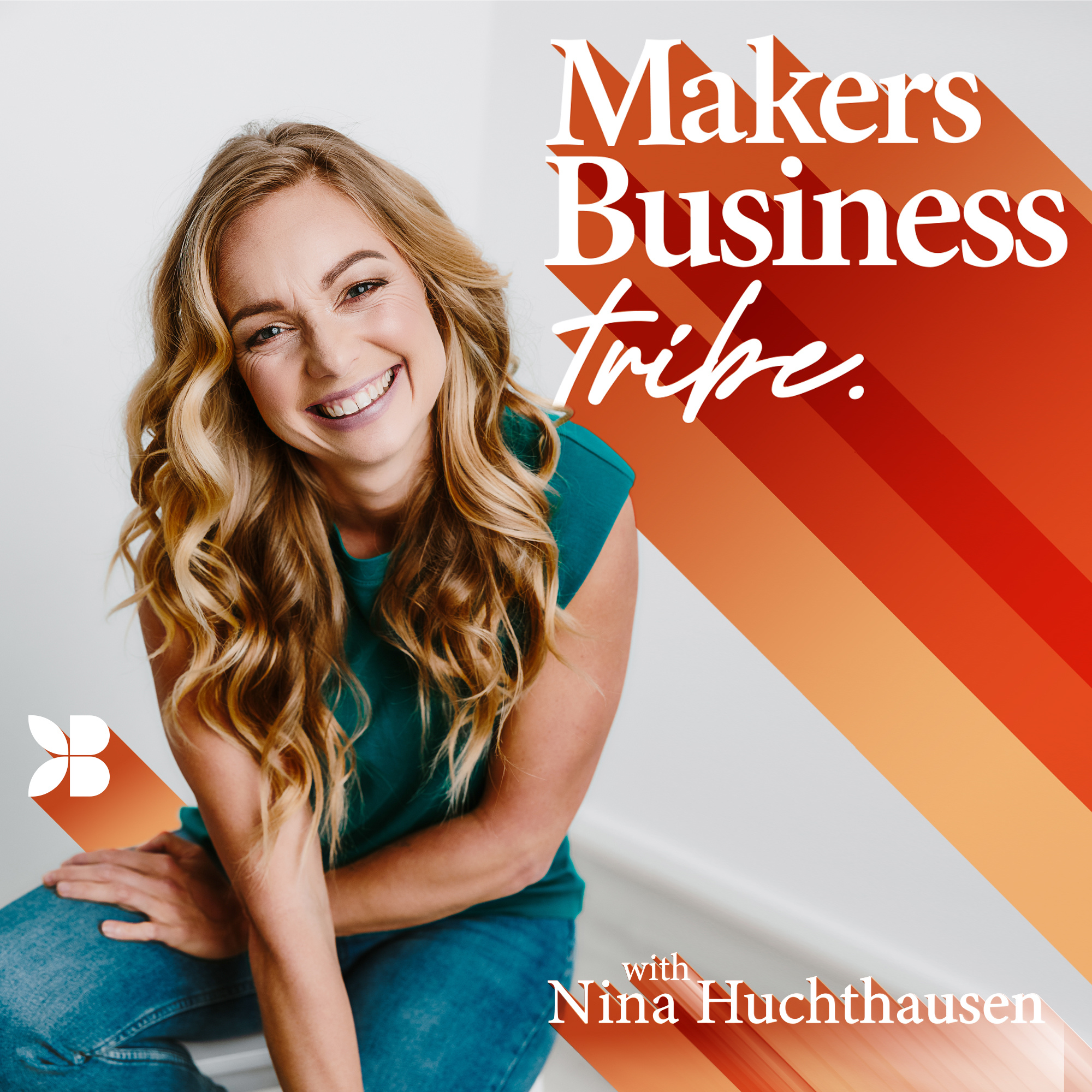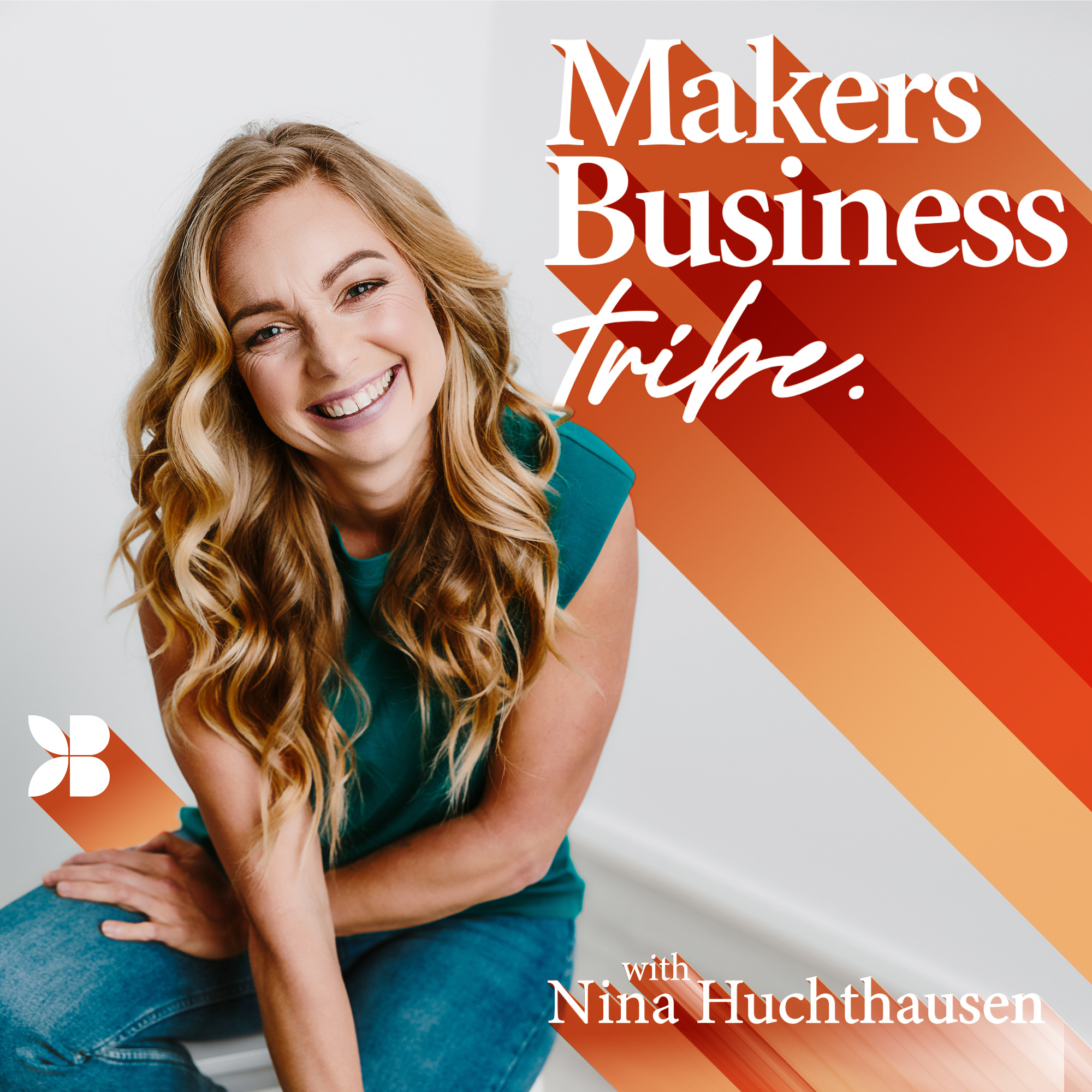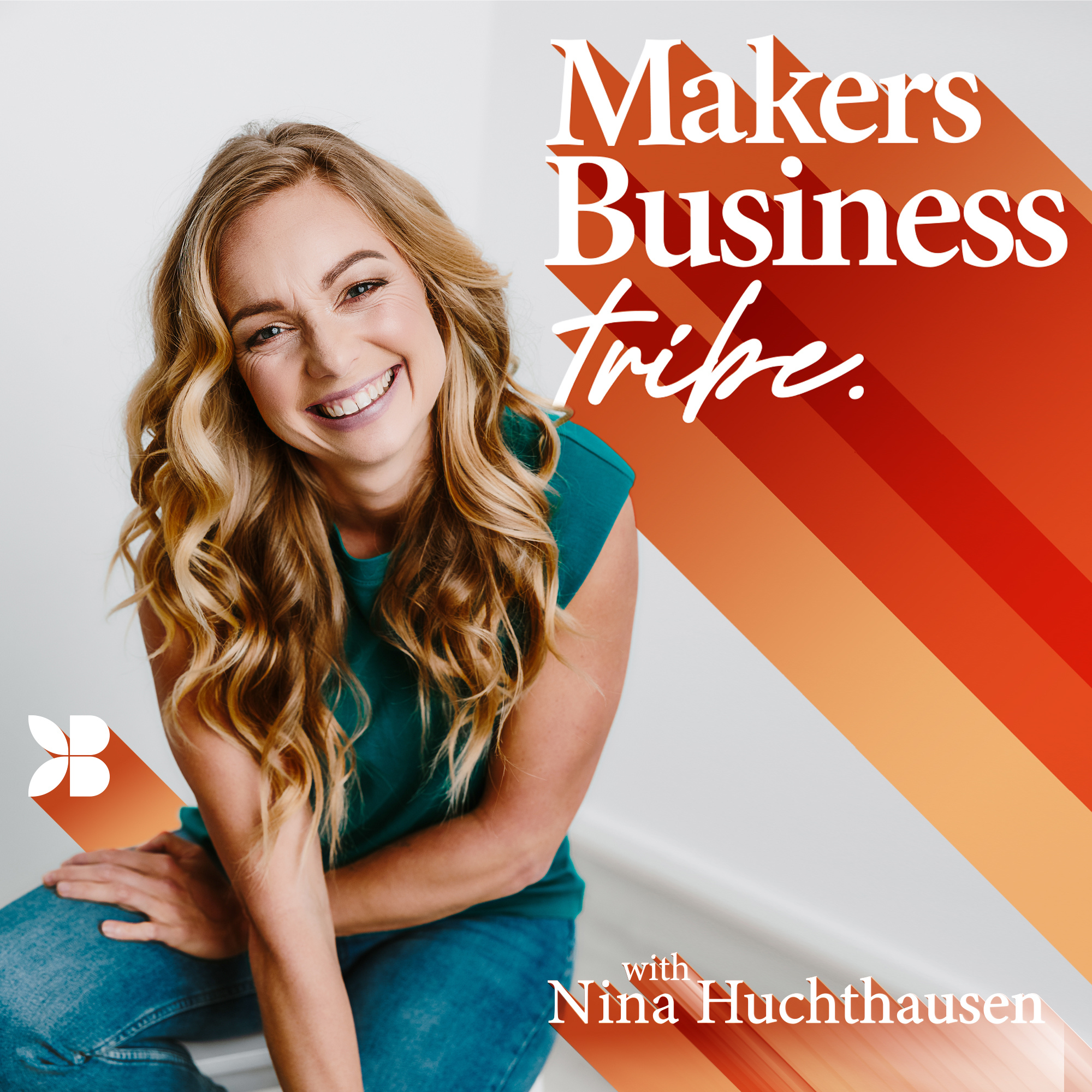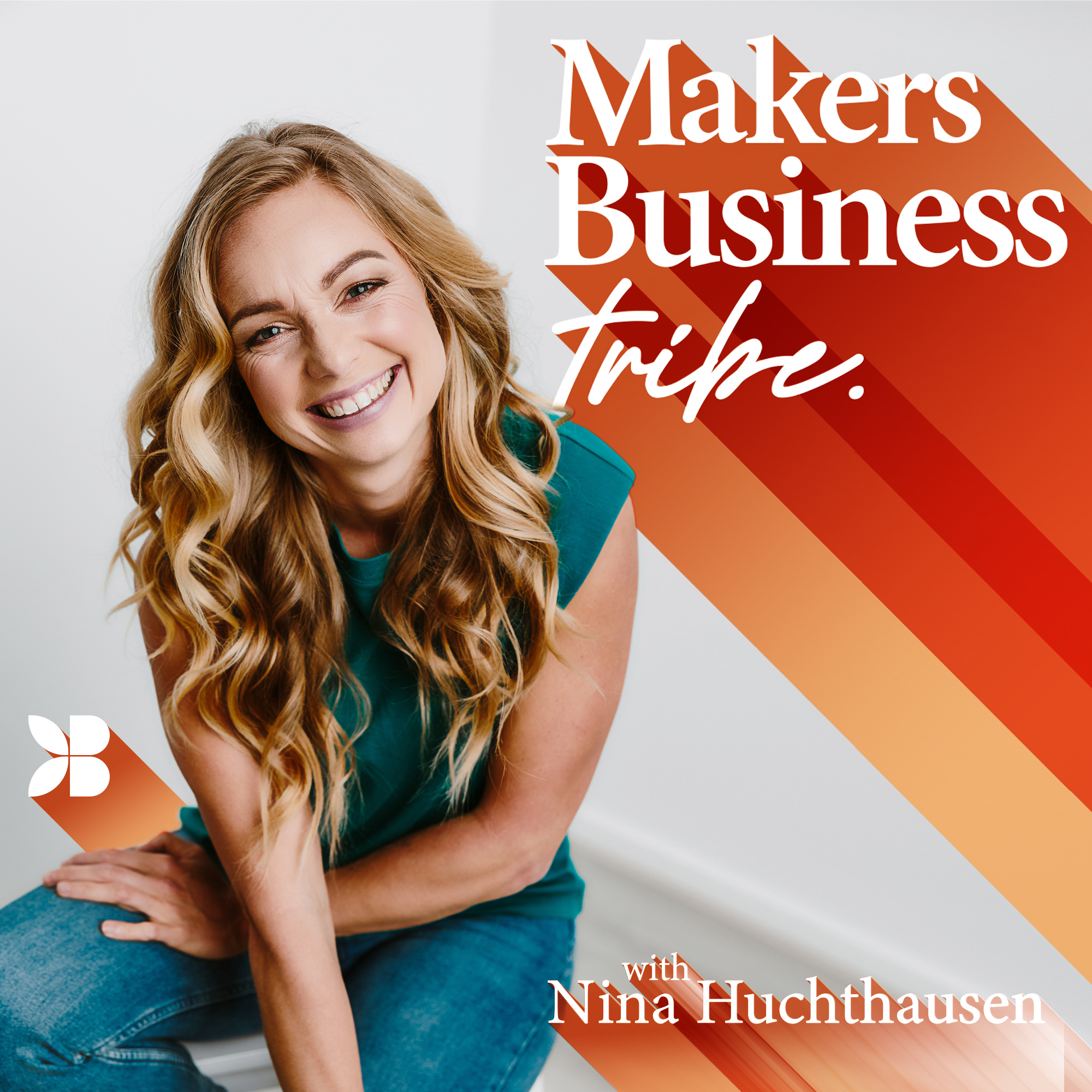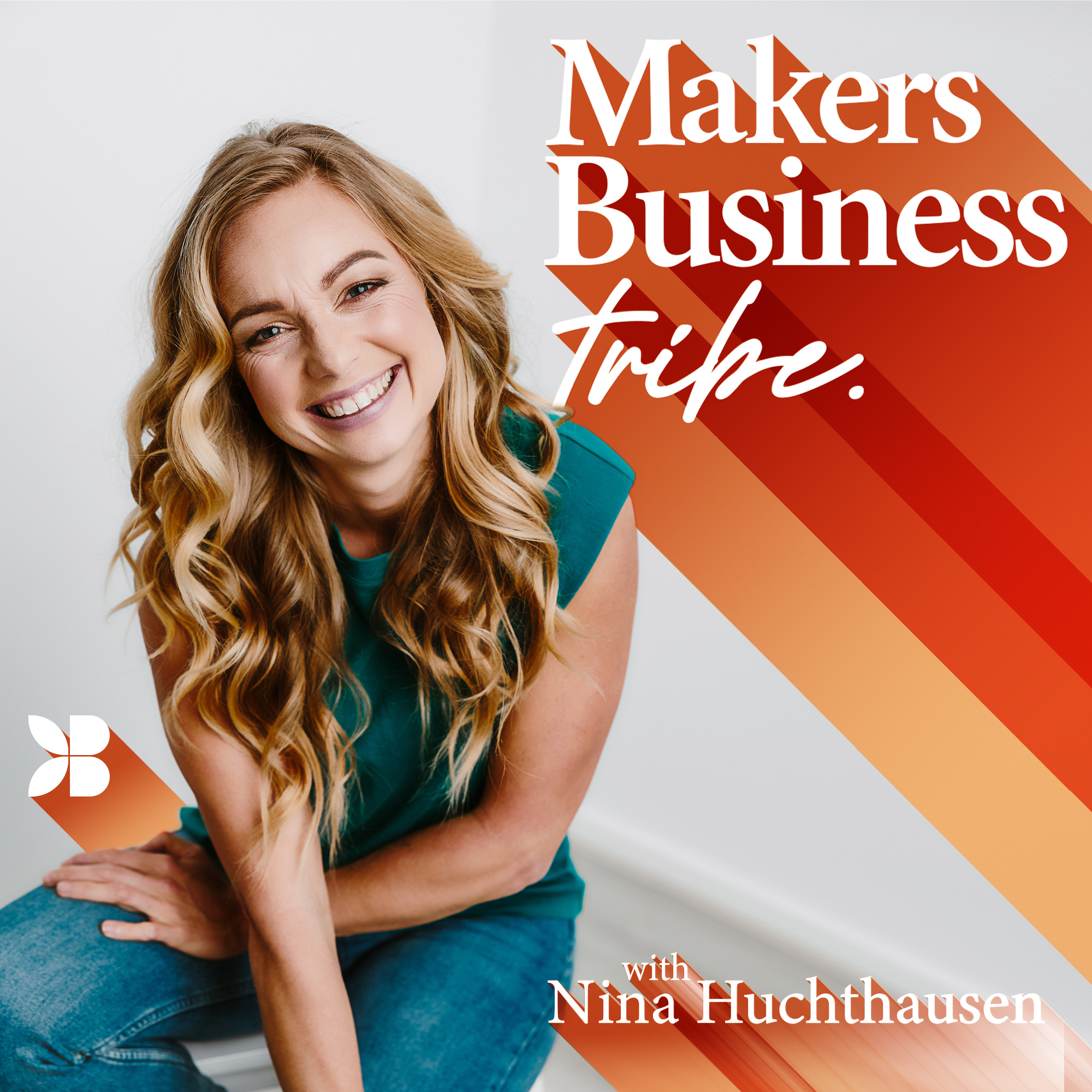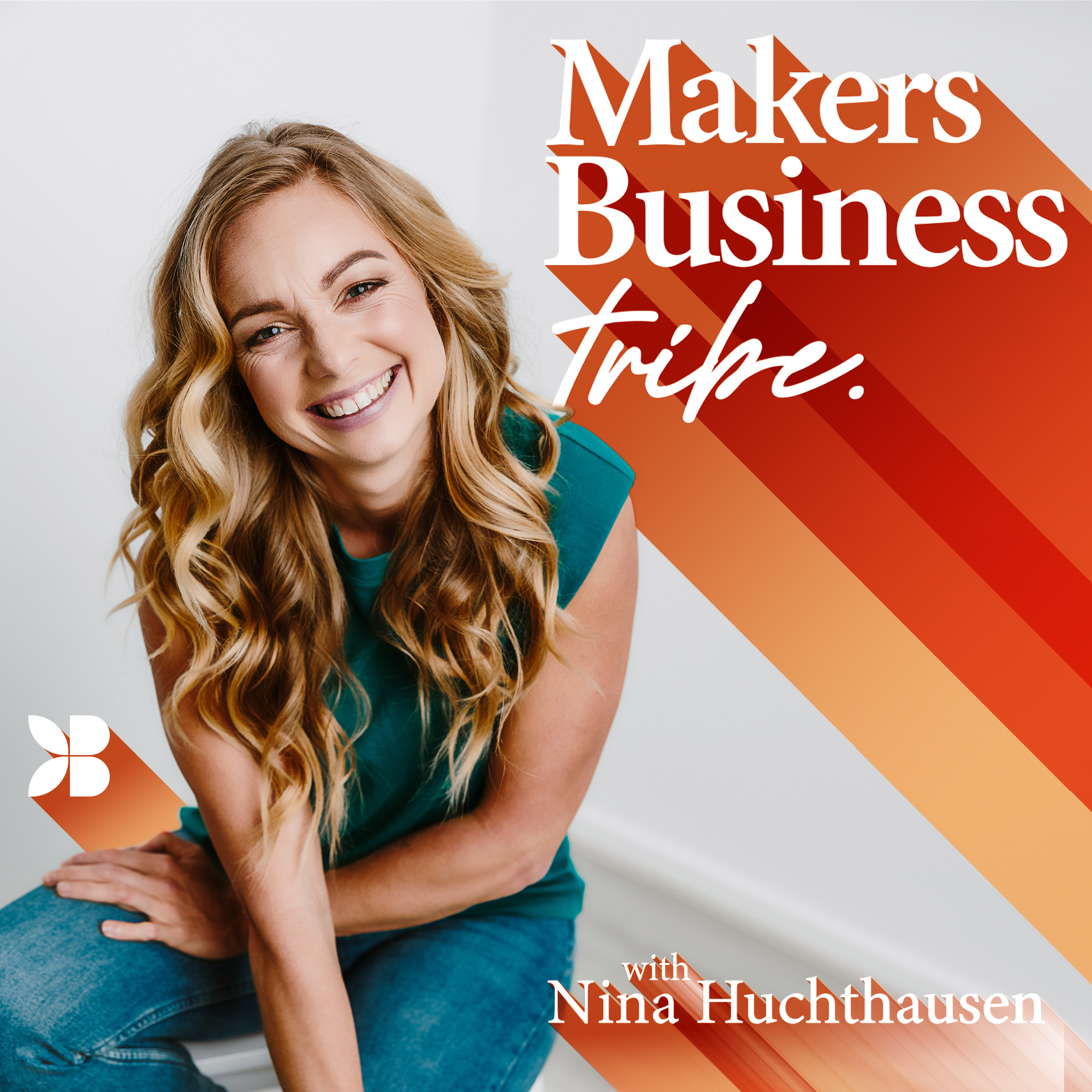Episode Transcript
Nina Huchthausen (00:05.966)
Hello everyone and welcome to the Makers Business Tribe podcast. Now, in this week's episode, I would like to remind you, hey, it's the end of June. End of June means, and not only end of financial year, but also the mid -year mark of this year. Where did the year go? my goodness. Like, I honestly, if I realized we are already six months in, I was a bit surprised because a lot of stuff happened.
in my business this year, a lot of growth, a lot of growth within the tribe, within our members that we are supporting, getting their products out into the world, into the retail shelves, and to...
Nina Huchthausen (01:05.038)
A lot of things have happened so far for me over the past six months. Well, not just for me, most importantly for our Triad members, right? That we are supporting to get the products into retail shelves all across Australia, as well as selling their products online, upgrading their branding, changing their packaging, moving their manufacturing from the home kitchen to...
an external manufacturer changing the way they ship, changing the way they deliver their products, all sorts, right? And when I started looking back at all of those results, as well as the challenges and the struggles that some moving through and some have overcome, I was like, well, let's do an episode on this because to me,
the more we can use these cycles that we as a country move through and do the same thing as pretty much the majority of businesses that are busy with. There's a certain type of energy to it. And I would say right now there's a bit of a reflective energy going on because now's the time to take stock. Accountants all over Australia are super busy to
get all of their clients to take stock. All of the businesses are super busy. Everybody who works in accounts receivable and payable are smashing the late nights to get all of the numbers in and salespeople all across the country are trying to sell, sell, sell as much as they can before the book's closed 30th of June. Okay. But where does it leave, does that leave us product based businesses or even like if you're a service based business, same dealio.
Well, where that leaves us with is number one, we are six months into the year. So chances are you have set some goals by the end of last year or beginning of this year, right? So that meaning you've been working towards those for the past two quarters or six months. So it's probably a good time to step back and see, have you smashed them? How close have you gotten to them?
Nina Huchthausen (03:28.654)
Are your actions, the actions that you've taken, have they been aligning and leading you closer or have you potentially set goals back then? You don't even know where you put them and you've just been doing random things and maybe you've been noticing sales are down or things are frustrating in the business or you're just tired and burned out no matter where you're at. Or best of all, you're really celebrating because you're like, damn girlfriend.
You smashed it. So no matter the situation, now's the time to get off, get off your horse, out of the business, away from the doing away from the laptop, away from your day to day and take advantage point, take advantage points. So you can objectively look at your business to see what's been happening, what has happened, what have I achieved?
What do I need to work through? Where are my weak points and where are my strengths in my business? Right? Because if you want to go places, yeah, if you want to climb Mount Everest from time to time, you can't just keep climbing. You need to take a look at your map. You need to orient yourselves. Where am I in relation to my goal? What's coming up? Do I need to adjust my path? Is the path that I'm walking the right one? Or am I just crawling through the shit? Right?
Because if you do, maybe it's time for a pivot. But if we just in it, in it, in it, it's very hard to stop and pause. So herewith, I will give you full license to stop and pause and take a look. Because chances are, if you're noticing something can be shifted and changed, you'll get to your goal so much faster. You'll get out of this shit. You'll solve your problems.
versus just keep on going, keep on going, keep on going, because sometimes things are not working best to be able to notice you are riding a dead horse. Get off. Choose a different one. OK? Sorry, I'm throwing all sorts of analogies in here. But I'm hoping you get just. So how can you do that? And so we've spent a little bit of time in the tribe recently, last week and this week, to take a look at a bunch of our data to
Nina Huchthausen (05:55.502)
find common trends, to find weak points, and to then align some action. Now, this required a lot of data pulling together and strategic work, but, and that's probably not the right format for me to talk you through on this podcast, but we can actually simplify this and pull a lot of insights together by looking at two sides of your business.
And that's what I want to talk you through because everybody can do that. So if you have a pen and paper, I would say just write that down for me. So number one, we want to take a look at your revenue side. Okay, your revenue side is the side of the business where money flows in. Okay. Number two is what we're going to look at in the moment is your budget and your cost side, which is where money flows out.
Why do those two paths? It's because revenue minus costs equals profit. Okay? So in a very simple, simplified way, if we take a look at our revenue and see is that healthy and have a look at our costs and see is that healthy, there will be some profit for us. If there's things unhealthy on either side of the coin,
We're not gonna be able to earn the fruits of our labor as much as if we fixed it. Okay? So step number one, let's take a look at your revenue. So here's what I would like you to do. If you're driving listening right now, I think you can do this in your head right now and you can do, you can take those actions later. I think there will be some comments in the show notes. So number one.
take a look at your overarching revenue goal. How much money in total did you plan to make? Did you set out to make at the start of the year, either within the six months time, then you should already be there or within 12 months time? Yeah. If you decided you wanted to make certain amounts of money within three years time, well, then you can calculate that down, right? Where should you be six months in to your three year journey? Yeah.
Nina Huchthausen (08:22.798)
So whatever that is, that's the first number you want to write down. What was that overarching revenue goal? And then maybe you have it, maybe you don't, but it's a good thing to figure out next round. Break that down based on the channels, the sales channels that you're operating. Yes. So ideally what you would want to have done is you have your overarching revenue goal and you have broken that down into if you're selling in retail.
What was your retail goal into if you were selling an e -com? What was that goal? If you were selling at markets or events, what was that financial goal? Any other channels, email, Facebook ads, you name it, write that down too. Okay. So like, let's say if your overarching financial goal was a hundred thousand, then
and you have five channels you occupy, then maybe your goals were equal. So 20k each, or you might have had some other split. If you don't have a split, that's cool too. But maybe some food for thoughts to split it out next time. Because certain channels can only do so much. For example, if you are at markets or events, unless you're really smashing yourself during the year, they can only carry you so far.
Nina Huchthausen (09:58.958)
Okay, so they can only carry you so far.
Nina Huchthausen (10:14.094)
And then you want to take a look at your actuals. So very simply, you can go into your potentially zero. So any revenue conciliation platform will help you do that to show you across all of those channels how much revenue did you make. So even if you didn't know it, if you didn't set out your goals for retail, e -commerce market, and so forth,
And if you have some type of conciliation platform, you'll be able to see how much revenue in actuality, in reality, you have made based on each of these. And you will also see the total. And so I would write that out. So let's say your total was 90K. Yeah. And then you can see, okay, you might've made 50 from retail, 20.
from Ecom 1570 and 25 from markets. Cool. Even if you didn't have your starting point, then you can see, okay, which channels were the highest performance performing and which ones were the lowest performing across the past or for the past six months. Yeah. And we know, okay, I'm 5k short of my overarching target. Well,
You get five days to go. I'm recording it on 25th of June. So you can, you can still smash that. But if you don't really, you only need to make another five K on top of the hundred K for the next six months. Right. So to me, that's absolutely freaking amazing. If those are your results, you can goddamn high five yourself. Now here's what happens. So if you only pull the data for six months, you're missing out on
a lot of nuance on what might have happened each month. Because ideally you want to see and work backwards and get a better view on how did January go? How did February go? March, April, May and June? Why do you want to do that? Because unless you have a product that is completely independent of season, which is never really the case.
Nina Huchthausen (12:40.142)
And there'll be fluctuations and some months you'll be you might have had less retail revenue, more market revenue, less e -commerce and so forth. So it might be a little bit more bouncy. Some months you might also have a really good average revenue per customer. Other months you might have had very high volume, but lower average revenue per customer. So if you can,
In your system, I would see, can you split that out per month? Because that's where it gets powerful. Because that's where you can then see, OK, if in January retail was slow, e -com was up, why was that? Why was that is the key question. Why was e -com up? And then you might remember, I ran a
I ran a two for one sale, yeah, around the 26th of January. That was for like three days only, 72 hours. And actually that was really great performance. Holy crap, man. You want to write that down and you want to remember that because maybe you should do that again next year. If that next year, or maybe there's another period in time this later this year where you should run that competition again. Yeah.
Or, well, like the other side of the coin. Let's say in April, you had signed up to a lot of markets and they all got canceled because it was consistent rain. Yeah, that's why your market revenue was so down. You want to write down, holy crap, April, terrible months for markets. So meaning next month.
or next year in April, you might want to be extra careful as to how much you want to put your eggs into the market basket. Because if April happens to be a very rainy month every year, or not as super consistent months, then maybe you can strategize next year early what you're going to do instead in April to pick that revenue up in a different channel.
Nina Huchthausen (15:03.854)
So one of our clients, for example, they have had a really awesome trend that we've analyzed over the past six months. So here's the exact scenario what happened. In a certain month, they decided to go down to Tassie for AgFest. Okay. And they had not just booked AgFest, which I think runs for four to five days.
But they had then booked a whole tour around Tassie to visit a bunch of different retailers, existing ones and new ones after. Yeah. And then when they came back from Tassie, they did it. They did a little loop around Melbourne before they then drove back up to New South Wales. And here's what happened. So number one, Agfest was an absolute banger. Yeah. So they wrote down, okay, all the conditions that made this market such a banger. And that is
Because in that region, these big events don't happen often. And a lot of people in that area, they keep their money in their pockets until AgFest happens, and then they go and spend. OK? So that's a really great thing that you want to remember, because in places and areas like that, that's where you want to come back, because people are spending. Now, a second awesome thing.
that has happened there is because they didn't just do access and flew back, but they visited retailers afterwards. So some retailers had already heard about the product after the event. So they were very keen to chat. So they were able to sign them up, but also visiting existing retailers face to face meant that they got more reorders and faster reorders straight after this event. Yeah.
Then doing a tour around Melbourne, same thing happened. They signed up a bunch of new retailers and visited existing ones who then also placed reorders as well as also they got, they were able to increase their existing orders. And they could see an effect of that tour on AgFest until now, which I think is almost six weeks later.
Nina Huchthausen (17:25.614)
that still their retail revenues is way up. They've signed up way more. They had higher online orders during that period, which has been trickling off by now. And that led us to the conclusion on how effective for this team, not saying it's for you, but you want to take a look at your data and see what happens. But for them,
It really led us to the conclusion how effective it is to do these types of tours. Yeah. To visit a really banger event, meet a bunch of new customers, B2C, get the word out, and then taking the time to travel and see retailers or stockists that either might have heard or been to the event, so they've already been introduced to the brand, or
that you can actually talk to them about, about the event that you've been there, how great the sale was, which gives those retailers and stockists a lot more confidence, how powerful that is for the growth of their brand. So now a strategy that they are based on this data analysis, they're going to review is how can they clone themselves and have people
that do key events that they've identified tick the boxes that they believe can generate really great sales and brand awareness and recurring customers for them in different areas of the country. And not just doing those events, but then visiting the retailers afterwards that aren't around that area to see, hey, we had great results at this event selling to a bunch of customers. These customers will want
Our products, again, we want to stock it in your store so when they run out, we can direct them to you. Because ordering online, we know, costs you a bunch of money, takes too much time. It's a great opportunity because we know what this team of my MBT client in the current size was able to achieve financially if they cloned that in like two or three teams across the country.
Nina Huchthausen (19:48.782)
That number one is going to really dial out the number of stockists and the number of B2C market and event sales. Number two, if, let's say, April rains heaps in New South Wales, you dial down the markets there, but you get a team in a different area, in a different region of the country to run events and markets someplace else where there is no rain, for example, right? Or go to events that are undercover.
And ultimately what we've noticed is that these types of events also drive online sales. Now there are certain reasons why this team can't run online advertising. That's why we have aligned on offline advertising at this stage. But this awareness that that seems to be a recurring pattern and the power of this pattern of event, retail visits,
of new and existing ones and then the growth that occurs as well as offline and online has been I think very eye -opening and powerful for people. So my invitation to you when it comes to your revenue side, here's what I'd like you to do. Find or identify, look back at what was your target, your revenue target.
that you wanted to hit by the end of June, either calculate it down or find the number that you want to hit. Then pull some data. Look into your zero or MYOB or whatever you're using accounting software to see what was the actual revenue you made and how is that split across your different sales channels. And then filter it by months so you can see the data for January, February, March, April, May, June. And I would put that data side by side.
Yeah. In fact, I think I'm just going to link our forecast and actuals tracker as part of this podcast that will make it easy. So you have a sheet to fill in. Okay. And then you want to take a look and see what trends they are and pull the data and just write out what was that story? What did you do to them? See what was the results? What was the story for the month? What were the results? So that number one, you can make a call on, should I be doing that again?
Nina Huchthausen (22:16.398)
Should we continue doing that or should we stop doing that because it was horrible? Okay. And that my friends, if you just look at your revenue side, we'll go a huge way for you to make some really informed data -driven decisions so that you can then sit down and develop a plan of what you're going to do and how you're going to capitalize on the next six months ahead.
Of course, just past data cannot give you all the insights you need for the next six months because from back to back to school all the way to Christmas, different things are going to happen. But you can certainly take a whole bunch of data to get you your thinking started and then add to it your foresight for what you think will happen July.
Yeah, July, August, September, October, November, December. Okay.
So that is part number one, looking at the revenue side of your business. Now, let's take a look at the other side of the coin, which is your costs. Because that's where a lot of businesses tend to fall down. We don't want to look at our costs. We don't want to look at our spendings. We just hope for the best that the more money we make, the more we work, the more we work.
that there will be some money left at the end of the day. Okay? And it's not wholesome. It's not really serving you to, to live your best life. And it can also become very stressful because what if, what if it doesn't? What if your accountant tells you you literally made fuck all money because you spent too much at the end of the year? You don't want to wait for that. You want to be able to see that and you want to be able to rein it in.
Nina Huchthausen (24:19.15)
Yeah. And to make some really solid decisions here. So here's how we're going to look at the cost side. Now, ideally, you would have done a budget at the start of the year, a budget in which you have written down what is the maximum amount of spending you want to do in each area of your business. Yeah. What areas am I talking? How much money you want to spend when it comes to marketing?
marketing for retail, marketing for e -com, marketing for events, marketing for email, marketing on ads, blah, blah, blah, anything marketing. How much money do you want to spend on sales at a maximum? How much money do you want to spend on overhead expenses? How much money do you want to spend on product development, on photography, on legal, on accounting, on insurance, on events that you want to sign up on?
point of sales materials, you name it. Everything that you spend money on, instead of you just spending money away, you want to determine a budget at the start of the year where you decide, okay, this is the maximum. I'm not going to spend all of that because then what happens is at the start of the year, you know, okay, if I stick to this, my costs are going to be say 50k. Meaning if you're going to end up making 200k, that means 150k profit.
If you don't determine how much the maximum is you want to spend, you could easily spend a hundred K. Yeah. And then realize, holy shit, I burn a hundred K in random expenses. Yeah. Because the challenge is that there are a lot of people who think, my accountant wants me to spend as much as possible because it's going to reduce my tax. Yeah. To a degree, but not on bullshit. Yeah. Because
paying tax is good because it also shows us when we're making money and then we can actually use that money and invest it into things that create further growth for the business versus buying ourselves random lunches at events and redesigning our packaging three times in a year. Yeah, it's not wholesome. We don't need to do that. So.
Nina Huchthausen (26:42.094)
Here's what I would like you to do when it comes to the budget side. So if you happen to have created a budget, then you know what your targets were. So then you can go into Xero or MyoB and pull all of your expenses and see if you can categorize it, ideally based on the categories that you have in your budget, because then you can literally compare line item by line item, the target figures, your budget, as well as your actual cost.
That's the easiest scenario. Let's say that's what you can actually do. OK? Best case scenario. Here's then what I would like you to do. Anywhere where you were over, you want to see, OK, was that OK? Was that an informed choice that I made? And maybe should I update my budget? Because the number has to be higher in terms of expense.
Number one and number two. Yes. There was a big return on investment Yeah, that's the first pass you want to give yourself when you look at your your your your target figures versus your actual figures But there's a second pass, too You also want to go through those line items and see what is that money wisely spent?
Was that money wisely spent? And you don't need to have a budget for it. Even if you just look at your expenses in isolation. Let's say you don't have a budget. You want to take a look at all of those line items and ask yourself, did I spend my money wisely? Or did I have this illusion because the business is paying for it? It's OK. Or.
Did I just get excited about something and signed up for random things? Or are there also line items in there, especially subscriptions that you don't even know what this is? Or you might have logged in once, or you don't even know the password anymore, or something, something. You want to highlight those in big red and pull that out. Because ultimately, this is the real power of
Nina Huchthausen (28:58.99)
this six month review, you can get really critical about anything that you're currently spending money on and asking yourself, is it worth? Was it worth spending money on it? Number one, because maybe it was. And number two, will it be in the future? Or is now the time to get off that horse and stop spending? Because if you don't see or have not seen a return on investment,
Now is the time to say no and reevaluate and see what am I going to do instead. For example, is a very classic one. One of our clients, when they first started working with us, they casually told me that they've been working with an agency and have been running ads for five months. And the agency told them that it's very normal.
that the ads are not performing yet. It can take up to 12 months for the algorithm to kick in. So they will have to keep spending. I think they were spending about 5k on ad money a month. And in 12 months time, the ads are supposed to start performing.
Nina Huchthausen (30:16.782)
You decide whether that's bullshit or not. Okay. But any ads that need to run for a whole year, I would question myself, really, is that what's supposed to be? Because an ad is like a sign flicker in front of a store. If there has to be a dude on the street in Sydney CBD having to flick a sign for 12 months until there's one person entering the store.
I would say something is wrong. Something is wrong either with the offer or with the positioning or with my brand. So if there's something that's not performing, I would rather stop it and reevaluate the whole thing than keep spending on it. Yeah. And same situation could actually be just with subscriptions that you're not using or tools that you're wrangling with, right? That you're like, yeah, okay.
Sign up zero, okay? As an example, you're hating it. You're not liking it. It's getting your head in. There is a great way for you to look at it. It's like, why the fuck am I paying for this? Yeah. Either your decision could be, okay, I'm going to YouTube the heck out of this and study it and learn it so I'll get better. So I start loving it. Or maybe number two, I'm going to have a conversation with my account and see what else can I do because it's just killing me from the inside.
That's how you can go through every single line item and ask yourself, is it worth it? Yeah. Because at the end of the day, you are working so damn hard for every single cent. Are you happy for it to just leak out of your account like that without you defending it, like you're life dependent on it?
Unless you're making 10 million a year and you're like, I don't care about that million that I'm not being very efficient at. Unless you're at that stage, I would say buckle up and be really critical with your budget and hold on tight to it. And I'm not saying not spend it at all, not doing smart investment decisions, but be extra smart and remind yourself that the smarter you are with
Nina Huchthausen (32:38.414)
Return on investment thinking.
Nina Huchthausen (32:49.742)
the return that I'm getting. Don't or you see huge amounts of pain, problem, struggle, frustration. Maybe now is the time to stop it. Okay.
So if you can do that for me, whether you got a budget or not, you just go through your line items and see which one are you happy with to keep investing in, which one are you stopping, and then actually take action. Your business over the next six months will thrive even more. And if you don't hit your overarching revenue targets, but you've been able to reduce your cost profile, you might end up with the same amount of profit.
but didn't have to work as hard. And how good would that be? Or you might create better cash flow, more cash flow that you can actually invest into something that could duplicate your growth or triple your growth in some shape or form. Or you might be able to afford that warehouse, or you might be able to afford to do a much larger order of raw ingredients than you were able before.
So the more you can really look after your cash flow and hold onto it, the more opportunities you might create for your business in the future. So yeah, those are the two big pillars. Pillar number one, revenue analysis. Pillar number two, cost analysis. To step back on, reflect, take advantage, point.
draw as much insights as you can and then make some decisions. That's the most important thing, make some really solid decisions. And then after that, you wanna sit down and decide what's my path for the next six months? What insights am I gonna carry forward? And what additional steps do I need to take based on the season ahead? Yeah, you also then wanna look out and see, okay, July till December, what's happening?
Nina Huchthausen (34:57.294)
what is going to happen and how can I best capitalize on that to grow my revenue and keep my costs set by.
So with that, my friends, I hope you have a wonderful rest of the week. I love you and leave you with this, analysing your business, make some informed decisions and see how much growth you can create for you over the next six months.
